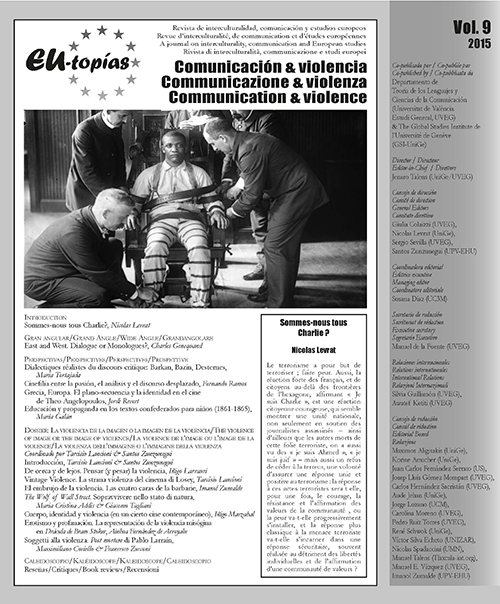El embrujo de la violencia. Las cuatro caras de la barbarie
DOI:
https://doi.org/10.7203/eutopias.0.18751Keywords:
Violence, representation, audiovisual, semiotics, figurative Abstract
Abstract
This text deals with the phenomenon of violence from the point of view of its forms of expression, arguing that the formidable visibility of violence in our iconosphere is due in great part to its symbolic effects. In other words, violence is now a captivating show because, among other reasons, humans have managed to build several figurative formulas that are able to conjugate both economic and aesthetic efficiency. This article gives an account of the representation of violence in the discourse of cinema, television and documentary by analysing the formal strategies at work in each discourse and by pointing to the differences between the regimes of transformational and referential writing. Several revealing examples are used to point to the formal mechanisms that give support to the aesthetic models in which audiovisual inscriptions of barbarism can be found.
 Downloads
Downloads
 References
References
Bourdieu, Pierre (2001), Langage et pouvoir symbolique, Paris: Seuil.
Fanon, Frantz (1967), Black Skin, White Masks, New York: Grove Press.
Fish, Stanley (1980), Is There a Text in this Class? The Authority of Interpretive Communities, Cambridge: Harvard University Press.
Hall, Stuart (1980), «Encoding/Decoding», Centre for Contemporary Cultural Studies (ed.), Culture, Media, Language: Working Papers in Cultural Studies, 1972-79, London: Hutchinson, pp. 128-138.
— (2004), «Codificación y decodificación en el discurso televisivo», CIC: Cuadernos de información y comunicación, 9, pp. 215-236.
Shohat, Ella & Stam, Robert (1984), Unthinking Eurocentrism. Multiculturalism and the Media, London: Routledge.
Zumalde, Imanol & zunzuneGui, Santos (2014), «Ver para creer. Apuntes en torno al efecto documental», L’Atalante. Revista de Estudios Cinematográficos, 17, pp. 87-94.
Zunzunegui, Santos(2005),Lascosasdelavida.Lecciones de semiótica estructural, Madrid: Biblioteca Nueva.
— (2009), «Sonata de espectros», Victor I. Stoichia (ed.), La sombra, Madrid: Museo Thyssen-Bornemisza & Fundación Caja Madrid, pp. 70-81.
Downloads
Published
How to Cite
-
Abstract190
-
PDF (Español)70
Issue
Section
License
![]()
The authors conserve the copyright. All content published in EU-topías. Journal of interculturality, Communication, and European Studies are subject to the license Creative Commons Attribution-NonCommercial-ShareAlike 4.0 license. The full text of the license can be found at <http://creativecommons.org/licenses/by-nc-sa/4.0>
They may be copied, used, disseminated, transmitted and publicly displayed, provided that:
- The authorship and original source of the publication is cited (journal, publisher and URL of the work).
- They are not used for commercial purposes.
- The existence and specifications of this license of use are mentioned.
It is the responsibility of the authors to obtain the necessary permissions for images that are subject to copyright.



